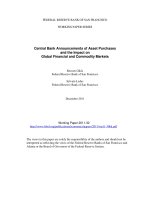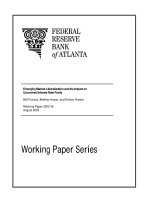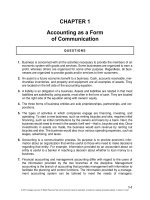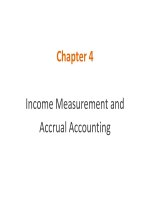Financial accounting the impact on decision makers 9e chapter 1
Bạn đang xem bản rút gọn của tài liệu. Xem và tải ngay bản đầy đủ của tài liệu tại đây (1.73 MB, 39 trang )
Chapter 1
Accounting as a Form of
Communication
What is Business?
Consists
of activities necessary to provide
members of society with goods and services
LO 1
Exhibit 1.1—Types of Businesses
Exhibit 1.2—Forms of Organization
LO 2
Business Entities
An
organization operated to earn a profit
Sole Proprietorships: organization with a single
owner
Partnerships: business owned by two or more
individuals
Often used
by accounting firms and law firms
Corporations: entity organized under
a particular state
Ownership
evidenced by shares of stock
the laws of
Nonbusiness Entities
Organization
operated for some purpose other
than to earn a profit
Do not have an identifiable owner
Organizations and Social Responsibility
U.S.
business entities recognize the societal
aspects of their overall mission and have
established programs to meet these
responsibilities
Nature of Business Activity
Businesses
engage in three types of activities:
Financing
Investing
Operating
Activities
Activities
Activities
• Borrowing
• Sale of stock
• Purchase and
sale of assets
• Sale of
products/services
• Costs incurred
to operate
business
LO 3
Exhibit 1.3—A Model of Business
Activities
What is Accounting?
Economic
Information
Various Users
Management
Stockholders
Creditors
Financial analysts
Government
LO 4
Users of Accounting Information
and Their Needs
Internal Users:
Primarily
the managers of a company
Involved in the daily affairs of the business
External Users:
Not
directly involved in the operations of a business
Need information that differs from that needed by
internal users
Outsiders must rely on the information presented by
the company’s management
Management Accounting and
Financial Accounting
Management accounting
Branch of
accounting concerned with providing
management with information to facilitate planning
and control
Financial accounting
Branch of
accounting concerned with the
preparation of financial statements for outsider use
Exhibit 1.4—Users of Accounting
Information
Financial Decision Framework
1.
2.
3.
4.
5.
Formulate the question
Gather information from the financial
statements and other sources
Analyze the information gathered
Make the decision
Monitor your decision
The Accounting Equation
Assets
= Liabilities + Owners’ Equity
Left side: valuable economic resources and that
will provide future benefit to the company
Right side: indicates who provided, or has a
claim to, the assets
Stockholders’ equity or shareholders’ equity:
used to refer to the owners’ equity of a
corporation
LO 5
Source of Stockholders’ Equity
Created
when a company issues stock to an
investor
Retained earnings
Earnings accumulated or
retained by the company
Part of owners’ equity that represents the income
earned less dividends paid over the life of an entity
The Balance Sheet
Financial
statement that summarizes the assets,
liabilities, and owners’ equity at a specific point
in time
At any point in time, assets must equal liabilities
and owners’ equity
Example 1.4—Preparing a Balance
Sheet
The Income Statement
Summarizes
the revenues and expenses of a
company for a period of time
EXHIBIT 1.5—The Relationship Between the
Accounting Equation and the Balance Sheet
Example 1.5—Preparing an Income
Statement
The Statement of Retained Earnings
Summarizes
the income earned and dividends
paid over the life of a business
Dividends: Distribution of the net income of a
business to its owners
Example 1.6—Preparing a Statement of
Retained Earnings
The Statement of Cash Flows
Summarizes
a company’s cash receipts and cash
payments during the period from operating,
investing, and financing activities
Example 1.7—Preparing a Statement of
Cash Flows









